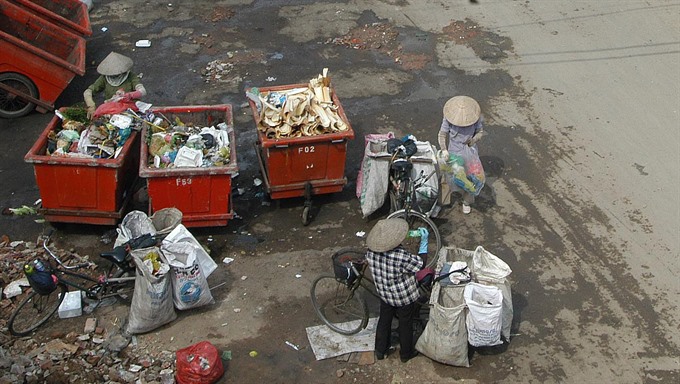 Society
Society

To tackle the pressing issue of waste treatment, HCM City has called for investment in waste-to-energy projects using advanced technologies.
 |
| A site where waste is collected before being taken to a waste-treatment plant in HCM City. — VNA/VNS Photo Thanh Phàn |
HCM CITY – To tackle the pressing issue of waste treatment, HCM City has called for investment in waste-to-energy projects using advanced technologies.
At a seminar held last weekend, Trần Vĩnh Tuyến, Vice Chairman of the municipal People’s Committee, said one of the biggest challenges now is to find an effective way to treat solid waste, which is increasing exponentially.
Figures from the municipal Department of Natural Resources and Environment show the city generates 8,700 tonnes of domestic waste every day; 76 per cent of this amount is buried, 14.7 per cent is turned into compost and 9.3 per cent is burnt.
Little recycling is done due to lack of garbage sorting at source, the department said.
The city also generates 1,500-2,000 tonnes of industrial and hazardous wastes and 22 tonnes of medical waste daily.
According to Nguyễn Toàn Thắng, the department chief, the volume of domestic waste is increasing by 5 per cent a year.
Industrial and hazardous wastes would have increased by 1,000 tonnes a day by 2030 and medical waste would more than double by then.
However, new technology paints a promising scenario where the huge volumes could mean a potential source of power.
Thắng said the city plans to solicit investment in two or three projects to produce electricity from domestic waste, one from industrial waste and one from medical waste.
To attract and select investors, Nguyễn Thành Phong, Chairman of the city People’s Committee, said there would be transparent public procedures and criteria.
He said around 40 investors have submitted proposals on waste treatment technologies to the city’s administration.
But Thắng said they should carefully analyse the characteristics and components of the city’s waste and its geological conditions since the domestic waste has high moisture levels and is usually not sorted.
Phong said existing waste treatment companies in the city should improve technologies or adopt new ones to boost efficiency.
City Party Committee Secretary Nguyễn Thiện Nhân said the southern economic centre would soon invite bids for the planned waste treatment projects.
“HCM City will make use of its special mechanisms [for this]. Hopefully, by the end of the first quarter of 2018 the process [for bidding and selecting investors] can be completed," he added.
City leaders said they want to adopt modern technologies and change the traditional way of treating solid waste which is burying.
The city has set itself a goal of reducing the percentage of buried trash by 50 per cent by 2020 and by 80 per cent by 2025, when waste will be treated using new technologies to produce electricity.
Experts at the seminar said burning garbage to produce energy has been done in many countries around the world and Việt Nam could follow.
But Deputy Minister of Planning and Investment Đặng Huy Đông said all technologies, including garbage incineration, has both its advantgages and disadvantages.
Burning garbage to produce electricity is similar to coal-fired thermal power, he said.
The city should be careful in choosing investors and give them three to six months to trial their technologies to assess their efficiency and environmental impacts before inking long-term deals, he added.—VNS
On Sunday more than 200 volunteers and local residents took part in a programme called “Cleaner Sài Gòn” to collect trash along the Nhiêu Lộc – Thị Nghè Canal in HCM City’s District 1. Volunteers also disseminated information to households residing on Hoàng Sa and Trường Sa streets on proper ways to dispose of garbage. The programme was part of a project to improve the environment in the city. Since its launch in 1999, the project has helped improve water quality and the environment on Nhiêu Lộc – Thị Nghè Canal, benefiting 1.2 million people living along it. The “Cleaner Sài Gòn” campaign will be launched in all districts in the city from now to 2022, with garbage collection and street clean-up campaigns held every month at garbage hotspots.—VNS |




